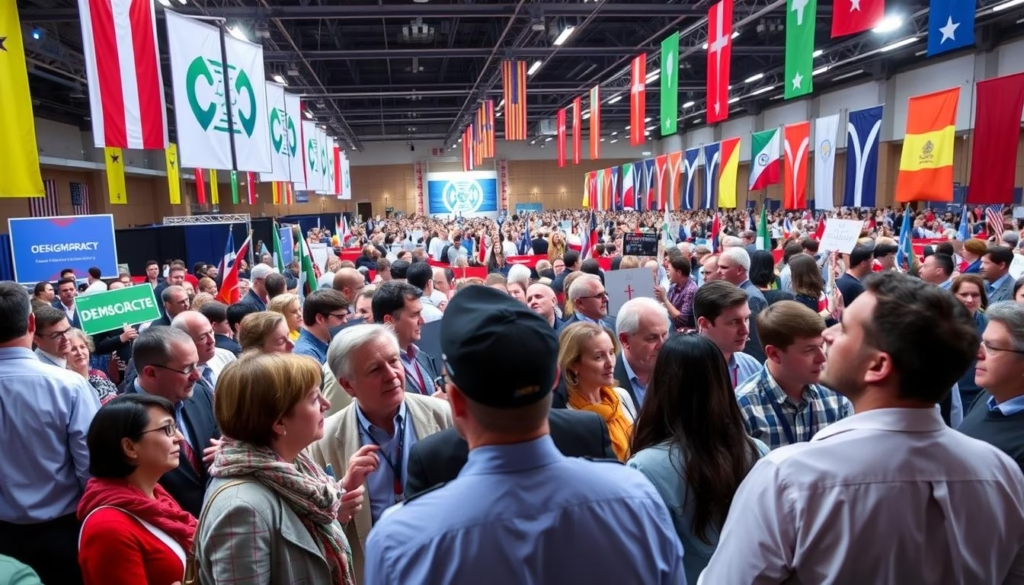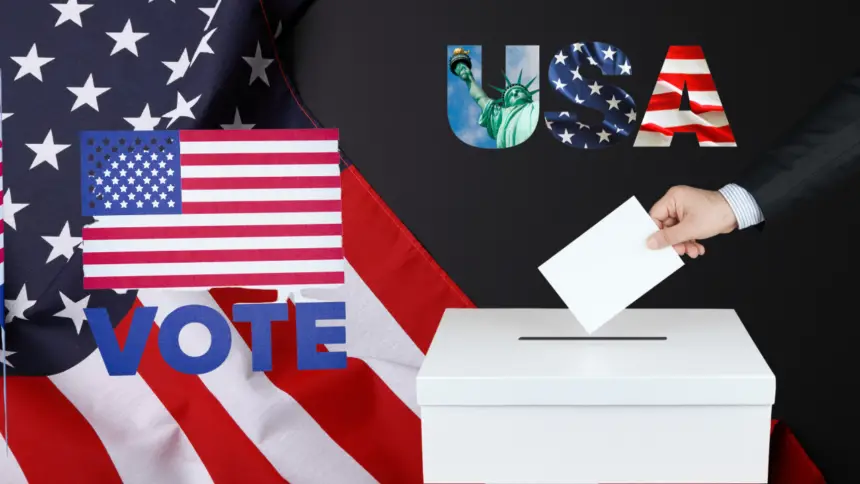The United States presidential election is a big event that grabs everyone’s attention. It happens every four years on the first Tuesday in November. Millions of Americans go to the polls to vote for the next President.
This process is complex. It includes primaries, caucuses, national conventions, and a general election campaign. The Electoral College system also plays a key role.
To run for President, candidates must meet certain rules. They must be at least 35 years old, born in the United States, and have lived here for 14 years. The two main parties, Democrats and Republicans, choose their candidates through primaries and caucuses. This leads to their national conventions.
The general election campaign is long and intense. It involves a lot of media coverage, debates, and fundraising. The candidate who wins is not decided by the most votes nationwide. Instead, it’s the Electoral College system that decides, based on each state’s number of electors.

Key Takeaways
- The US presidential election occurs every four years on the first Tuesday in November.
- Candidates must meet specific eligibility requirements, including age, birthplace, and residency.
- The election process involves primaries, caucuses, national conventions, and a general election campaign.
- The winner is determined by the Electoral College system, not the national popular vote.
- The president-elect is inaugurated on January 20 or 21 in the year following the election.
Overview of the Presidential Election System
The United States presidential election system is built on a strong constitutional base. It requires candidates to meet age, citizenship, and residency standards. The U.S. Congress, with its House of Representatives and Senate, is key in setting the election’s timeline and rules.
Constitutional Framework
The U.S. Constitution sets the basic rules for presidential elections. It uses the Electoral College to choose the president, with each state having a number of electors based on its Congress members. States use either winner-take-all or proportional voting to decide how these electoral votes are given out.
Election Timeline and Process
- Candidates from the Democrats and Republicans start their campaigns a year before the election.
- Primaries and Caucuses decide each party’s presidential nominee, focusing on states like Iowa and New Hampshire.
- National Conventions are where each party officially picks its nominee, with delegates voting.
- In the General Election, people vote for president and vice president. The one with the most electoral votes wins.
- The new president and vice president are sworn in in January after the election.
The U.S. presidential election system is complex but shows the country’s dedication to democracy. Knowing the constitutional framework, election schedule, and Congress’s role helps voters understand and participate in this important democratic event.
Primary Elections and Caucuses
The United States presidential election starts with primary elections and caucuses in the months before the national party conventions. These contests in states decide which presidential candidates will run for their political parties in the general election. It’s key to know how primaries and caucuses work to understand political campaigns and campaign strategies.
Primaries are run by state and local groups, where voters secretly choose their favorite presidential candidates. Caucuses are private events by political parties. Voters discuss and debate candidates before picking delegates for the national convention.
- The first state to hold its presidential primary was North Dakota in 1912.
- Both Democratic and Republican conventions include pledged and unpledged delegates.
- Republicans have three top party officials as unpledged delegates from each state and territory.
- Democrats have “superdelegates,” a group of party leaders and elected officials, as unpledged delegates.
- If no candidate gets a majority of delegates, a “brokered convention” happens. Delegates can switch until a winner is found.
The staggered nature of the primary season lets candidates focus on certain areas at different times. This means early-voting states like Iowa and New Hampshire have a big impact. Candidates often need to do well in these states to keep their momentum.
| Primary Type | Voter Eligibility |
|---|---|
| Open Primary | Voters from any party affiliation can participate |
| Closed Primary | Voters must be registered with the specific party to participate |
| Partially Open/Closed | Varying rules on party affiliation and ballot choice declaration |
Primaries and caucuses are key in shaping the presidential election landscape. They let voters directly choose their party’s nominee. Knowing the details of these contests is vital for following political campaigns and campaign strategies of presidential candidates.
US President Election: The Campaign Trail
Presidential campaigns in the United States are well-planned. They involve a lot of organization, fundraising, and media relations. Candidates have teams to help plan and run their campaigns. Their goal is to get people to vote for them all over the country.
Campaign Organization
A strong team is key to a successful campaign. Candidates hire experts in politics, communications, and organizing. These teams manage the candidate’s schedule, plan events, and get volunteers ready in important states.
Fundraising and Strategy
Finding enough money is essential for a campaign. Candidates get funds from donations, PACs, and parties. They use polling data and voter demographics to find the best donors.
Media Relations and Public Appearances
Today, candidates must deal with many media outlets. They use debates, town halls, and rallies to talk to voters. This helps them share their message and stand up for their policies.
In 2024, Donald Trump made a big comeback. He beat Vice President Kamala Harris, despite facing legal issues. His win was seen as one of the biggest comebacks in U.S. history.
“The 2024 election was a testament to the enduring power of the political process and the resilience of the American electorate.”
| Candidate | Electoral Votes | Popular Vote |
|---|---|---|
| Donald Trump | 312 | 51.2% |
| Kamala Harris | 226 | 47.8% |
National Party Conventions
Every four years, the major political parties in the United States hold national conventions. These events are key in the presidential election process. Delegates from each state, the District of Columbia, and U.S. Territories come together to confirm their candidates.
The number of delegates varies by state and jurisdiction. This is based on a formula set by the parties. Candidates need a majority of delegates to win the nomination, following party rules. Some delegates are pledged to support a candidate, while others are unpledged.
The national convention is also where the presidential nominee picks their running mate. This choice is very important for the general election campaign.
While conventions were once key in picking nominees, primaries and caucuses have changed this. Now, most delegates are chosen through these contests. They must usually vote for the winner of their state’s contest on the first ballot.
| Statistic | Value |
|---|---|
| Number of times Chicago has hosted major party conventions | 26 |
| Year of the first presidential primary | 1901 (Florida) |
| Year of the first direct open primary | 1905 (Wisconsin) |
| Year Oregon established a presidential preference primary | 1910 |
| Year when many states adopted the binding primary election | 1968 |
The power of party leaders has decreased. This is because delegates must vote for the winner of their state’s contest. Public-opinion polls also play a big role, showing who is popular and where.

“The growth of presidential primaries, especially after 1968, increasingly limited the role of conventions to ratifying candidates selected by voters.”
The Electoral College System
The U.S. presidential election is special because it uses the Electoral College system. This system has 538 electors who vote for the president, not a direct vote by the people. Knowing how electoral votes are spread out and how to reach 270 is key to understanding American elections.
Distribution of Electoral Votes
Each state gets a number of electors based on its Congress members. The District of Columbia gets 3 electors, making the total 538. California has the most with 54, while Wyoming, Alaska, and North Dakota have the least with 3.
Winner-Take-All vs. Proportional Systems
Most states, 48 out of 50, use a winner-take-all system. This means the candidate with the most votes in that state gets all its electoral votes. But Maine and Nebraska are different, using a proportional system where votes are split by congressional district.
Path to 270 Electoral Votes
To win the presidency, a candidate needs 270 or more electoral votes. This can be done in many ways, thanks to the complex mix of states. Winning key swing states often decides the election, even if the winner didn’t get the most votes nationwide.
“The Electoral College is an antiquated, undemocratic system that does not reflect the will of the American people and should be abolished.”
Many, over 60%, want to get rid of the Electoral College, polls show. Yet, despite many attempts to change it, it’s still a big part of U.S. elections. It shapes strategies and results in every election.
General Election Process
The general election in the United States is a key part of the presidential election. During this time, U.S. citizens vote for the president and vice president. But, they’re actually voting for electors who will represent their state in the Electoral College.
The candidate who gets the most votes in a state usually gets all that state’s electoral votes. Maine and Nebraska are different, using a proportional system. The candidate with the most electoral votes, usually 270 or more, becomes the President.
Voters can cast their ballots in person or by mail. With a focus on election security, keeping the voting process safe is a big concern. It’s important for both voters and election officials.
The general election marks the end of a long presidential election cycle. This includes primary elections, party conventions, and the campaign trail. By voting, citizens help shape the nation’s future. They also influence the voter turnout that decides the election.
| Key Facts about the General Election Process | Data |
|---|---|
| Total Electoral Votes | 538 |
| Majority Needed to Win | 270 |
| States with Laws Binding Electors | 29 states and D.C. |
| Example of Binding State | California |
| Political Parties Certified in California | 6 |
| California Primary Election Type | Top-Two Open Primary |
| Non-Partisan Contests in California | Superintendent of Public Instruction, Judge of the Superior Court, County Offices |
| Write-in Candidates | Allowed in Primary, Restricted in General |
“The right to vote is the foundation of our democratic process, and we must protect it at all costs.”
Role of Swing States in Presidential Elections
The U.S. presidential election is heavily influenced by swing states. These states are crucial because their votes are often up for grabs. Candidates focus a lot on these states because winning them can lead to victory.
Key Battleground States
Some states are always key in presidential elections. These include Pennsylvania, North Carolina, Georgia, Michigan, Arizona, Wisconsin, and Nevada. They are known for their unpredictable voting patterns.
Recent data shows that a small number of voters in these states can decide the election. Candidates spend a lot of time and money in these states to win.
Historical Impact on Elections
Swing states have been crucial in U.S. elections for decades. Between 2000 and 2016, many states voted the same way, but swing states decided the winner. In 2020, the margins in states like Arizona and Georgia were very small.
The National Popular Vote Interstate Compact aims to change how presidents are elected. But for now, swing states are still key in campaigns.
Swing states are the focus of intense campaigning. Candidates spend a lot of resources here. They might also get more federal funding because of their importance.
| State | Electoral Votes |
|---|---|
| California | 54 |
| Texas | 40 |
| Florida | 30 |
| New York | 28 |
| Alaska, Delaware, the District of Columbia, North Dakota, South Dakota, Vermont, and Wyoming | 3 (minimum) |
Swing states can change their voting patterns over time. This can happen due to many reasons, like demographic changes. Even small counties in these states can have a big impact on the election.
Voting Methods and Security
The United States uses different voting methods to keep elections fair. People often vote in person at polling stations. But, more people are using mail-in ballots, especially during the COVID-19 pandemic.
Keeping elections safe is very important. Almost all voters use paper ballots, which help with audits and recounts. States also have strong security checks for mail ballots, like checking signatures and using special paper.
Election officials look into any voting issues carefully. They test voting machines to make sure they work right. Most states make sure their voting systems meet high security standards.
Some people have said there’s voter fraud, especially with Dominion systems. But, there’s no proof of votes being changed or systems being hacked. Still, there are efforts to check election results and prove there’s no fraud.
Voters can help keep elections safe. They can work at polls, report any voting issues, and ask local election offices about security. This helps keep the voting process trustworthy.
| Statistic | Value |
|---|---|
| Voters with a paper ballot record | Over 98% |
| Duration of ballot storage after federal elections | 22 months |
| Voting systems certified by the Election Assistance Commission | Most states |
| Votes cast with a paper record in US election systems | Approximately 97% |

“Election crimes should be reported to local law enforcement, state or local election offices, or the FBI.”
Even with ongoing concerns, the US has strong ways to keep elections safe. It’s important for voters to stay involved and for election officials to keep working hard. This helps keep our democracy strong and trustworthy.
Presidential Debates and Media Coverage
Presidential debates are key in elections, letting candidates share their plans and talk directly. These debates have rules and are moderated by well-known journalists. But, how much they sway voters is still debated.
Debate Format and Rules
The Commission on Presidential Debates (CPD) organizes these debates in the U.S. They follow a set format, with time for opening and closing statements. There are also times for candidates to answer questions and debate each other. The moderators help keep the debates respectful and on track.
Media Influence on Elections
The media’s role in elections is big, shaping what people think and do. Research shows debates can make viewers more informed, but they don’t always change votes. With social media, it’s harder to tell truth from lies, making it tough for voters to make informed choices.
FAQ
What are the basic requirements for a U.S. presidential candidate?
To run for president, you must be at least 35 years old. You also need to be born in the United States. Lastly, you must have lived in the US for the last 14 years.
How is the U.S. presidential election process structured?
The election process starts with primaries and caucuses. Then, there are national conventions and general election campaigning. The Electoral College system is used to choose the president. Local authorities run the election, with no national authority.
What is the role of Congress in the presidential election process?
Congress, made up of the House and Senate, is key in the election process.
How do primary elections and caucuses work?
Primaries use secret ballots and are run by local and state authorities. Caucuses are private events by political parties. Voters pick their favorite candidates. Then, organizers figure out how many delegates each gets.
What are the key elements of a U.S. presidential campaign?
Campaigns need a lot of organization, fundraising, and strategy. Candidates build teams and travel to get support and funds. They also do televised debates to share their policies and defend their views.
What happens at the national party conventions?
At conventions, parties choose their presidential and vice presidential nominees. State delegates vote for their preferred candidates. The nominees are announced at the end of the conventions.
How does the Electoral College system work in U.S. presidential elections?
The Electoral College has 538 electors, based on each state’s Congress members plus three for Washington D.C. Most states give all their electoral votes to the winning candidate. Maine and Nebraska split theirs. A candidate needs 270 electoral votes to win.
What is the general election process like?
In the general election, people vote for president and vice president. The candidate with the most votes in a state gets all that state’s electoral votes, except in Maine and Nebraska. The candidate with the most electoral votes wins the presidency.
What is the role of swing states in presidential elections?
Swing states, or battleground states, are very important in elections. They are uncertain, so candidates focus a lot on them. These states can decide who wins.
What are the different voting methods used in U.S. elections?
Voting can be in-person or by mail. Mail-in ballots have become more common. Ensuring election security is a top priority.
How do presidential debates influence the election process?
Debates are key, letting candidates share their policies and discuss directly. Media coverage shapes public opinion and affects voter choices.















